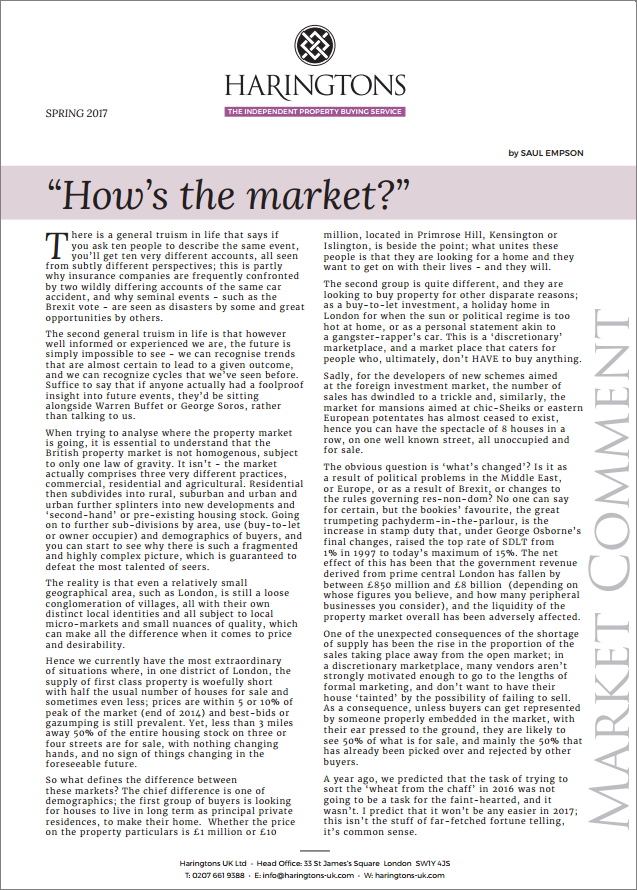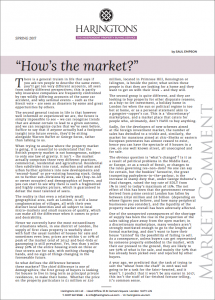There is a general truism in life that says if you ask ten people to describe the same event, you’ll get ten very different accounts, all seen from subtly different perspectives; this is partly why insurance companies are frequently confronted by two wildly differing accounts of the same car accident, and why seminal events – such as the Brexit vote – are seen as disasters by some and great opportunities by others.
The second general truism in life is that however well informed or experienced we are, the future is simply impossible to see – we can recognise trends that are almost certain to lead to a given outcome, and we can recognize cycles that we’ve seen before. Suffice to say that if anyone actually had a foolproof insight into future events, they’d be sitting alongside Warren Buffet or George Soros, rather than talking to us.
When trying to analyse where the property market is going, it is essential to understand that the British property market is not homogenous, subject to only one law of gravity. It isn’t – the market actually comprises three very different practices, commercial, residential and agricultural. Residential then subdivides into rural, suburban and urban and urban further splinters into new developments and ‘second-hand’ or pre-existing housing stock. Going on to further sub-divisions by area, use (buy-to-let or owner occupier) and demographics of buyers, and you can start to see why there is such a fragmented and highly complex picture, which is guaranteed to defeat the most talented of seers.
The reality is that even a relatively small geographical area, such as London, is still a loose conglomeration of villages, all with their own distinct local identities and all subject to local micro-markets and small nuances of quality, which can make all the difference when it comes to price and desirability.
Hence we currently have the most extraordinary of situations where, in one district of London, the supply of first class property is woefully short with half the usual number of houses for sale and sometimes even less; prices are within 5 or 10% of peak of the market (end of 2014) and best-bids or gazumping is still prevalent. Yet, less than 3 miles away 50% of the entire housing stock on three or four streets are for sale, with nothing changing hands, and no sign of things changing in the foreseeable future.
So what defines the difference between these markets? The chief difference is one of demographics; the first group of buyers is looking for houses to live in long term as principal private residences, to make their home. Whether the price on the property particulars is £1 million or £10 million, located in Primrose Hill, Kensington or Islington, is beside the point; what unites these people is that they are looking for a home and they want to get on with their lives – and they will. The second group is quite different, and they are looking to buy property for other disparate reasons; as a buy-to-let investment, a holiday home in London for when the sun or political regime is too hot at home, or as a personal statement akin to a gangster-rapper’s car. This is a ‘discretionary’ marketplace, and a market place that caters for people who, ultimately, don’t HAVE to buy anything. Sadly, for the developers of new schemes aimed at the foreign investment market, the number of sales has dwindled to a trickle and, similarly, the market for mansions aimed at chic-Sheiks or eastern European potentates has almost ceased to exist, hence you can have the spectacle of 8 houses in a row, on one well known street, all unoccupied and for sale.
The obvious question is ‘what’s changed’? Is it as a result of political problems in the Middle East, or Europe, or as a result of Brexit, or changes to the rules governing res-non-dom? No one can say for certain, but the bookies’ favourite, the great trumpeting pachyderm-in-the-parlour, is the increase in stamp duty that, under George Osborne’s final changes, raised the top rate of SDLT from 1% in 1997 to today’s maximum of 15%. The net effect of this has been that the government revenue derived from prime central London has fallen by between £850 million and £8 billion (depending on whose figures you believe, and how many peripheral businesses you consider), and the liquidity of the property market overall has been adversely affected. One of the unexpected consequences of the shortage of supply has been the rise in the proportion of the sales taking place away from the open market; in a discretionary marketplace, many vendors aren’t strongly motivated enough to go to the lengths of formal marketing, and don’t want to have their house ‘tainted’ by the possibility of failing to sell. As a consequence, unless buyers can get represented by someone properly embedded in the market, with their ear pressed to the ground, they are likely to see 50% of what is for sale, and mainly the 50% that has already been picked over and rejected by other buyers.
A year ago, we predicted that the task of trying to sort the ‘wheat from the chaff’ in 2016 was not going to be a task for the faint-hearted, and it wasn’t. I predict that it won’t be any easier in 2017; this isn’t the stuff of far-fetched fortune telling, it’s common sense.
Saul Empson, Director

